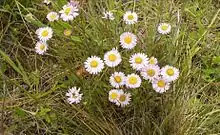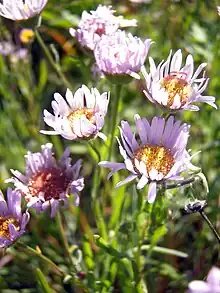Erigeron decumbens
Erigeron decumbens is a species of flowering plant in the family Asteraceae known by the common name Willamette fleabane. It is native to Oregon and California in the United States.
| Erigeron decumbens | |
|---|---|
 | |
| var. decumbens | |
| Scientific classification | |
| Kingdom: | Plantae |
| Clade: | Tracheophytes |
| Clade: | Angiosperms |
| Clade: | Eudicots |
| Clade: | Asterids |
| Order: | Asterales |
| Family: | Asteraceae |
| Genus: | Erigeron |
| Species: | E. decumbens |
| Binomial name | |
| Erigeron decumbens | |
The taxonomy of the plant varies by author. It may be treated as a species with two varieties,[1] the Californian variety var. robustior[2] and the rare and endangered Oregon variety, var. decumbens.[3] Alternately, the rare var. decumbens may be the only variety included within the species description and so named Erigeron decumbens,[4] with var. robustior separated and named Erigeron robustior.[5]
The Oregon plant, var. decumbens or alternately Erigeron decumbens, is a federally listed endangered species of the United States. There are 28 occurrences[3] growing in increasingly rare prairie habitat in the Willamette Valley.[6]
The plant is a perennial herb growing up to about half a meter long, and erect or decumbent in form. The Oregon plant is colonial with a branching caudex sending up several stems, and is severely threatened.[7] The inflorescence may contain many flower heads with white or blue-tinged ray florets that may dry pinkish.[4] The California plant is not colonial and the caudex branches little or not at all. The inflorescence contains no more than 3 heads. The florets are white or pink-tinged.[5]

References
- Erigeron decumbens. ITIS.
- Erigeron decumbens. Jepson Manual Treatment.
- USFWS. Erigeron decumbens var. decumbens Five-year Review. September 2010.
- Erigeron decumbens. Flora of North America.
- Erigeron robustior. Flora of North America.
- var. decumbens. Center for Plant Conservation.
- "NatureServe Explorer 2.0". explorer.natureserve.org. Retrieved 2022-05-29.
